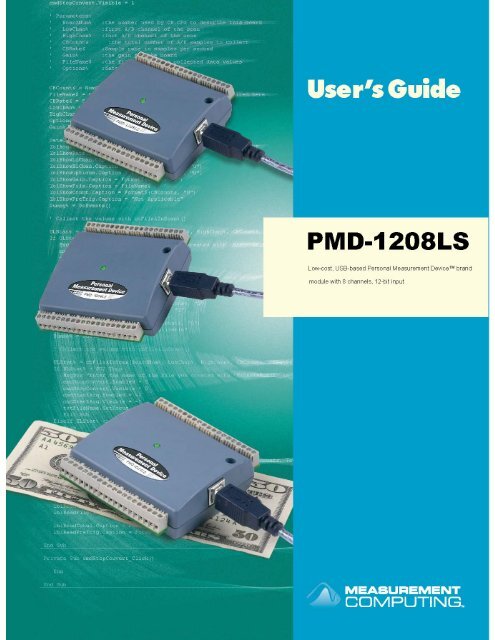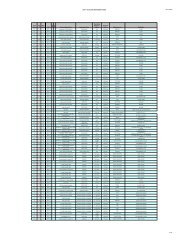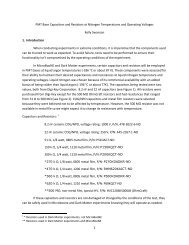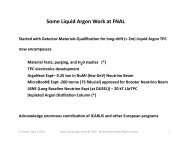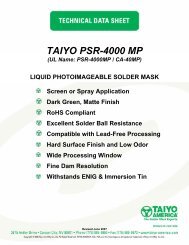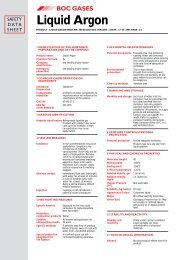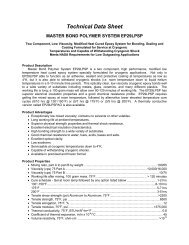PMD-1208LS User's Guide - LArTPC DocDB
PMD-1208LS User's Guide - LArTPC DocDB
PMD-1208LS User's Guide - LArTPC DocDB
You also want an ePaper? Increase the reach of your titles
YUMPU automatically turns print PDFs into web optimized ePapers that Google loves.
<strong>PMD</strong>-<strong>1208LS</strong>Personal Measurement Device brandUSB-basedAnalog and Digital I/O Module<strong>User's</strong> <strong>Guide</strong>Document Revision 8, May, 2005© Copyright 2005, Measurement Computing Corporation
Your new Measurement Computing product comes with a fantastic extra —Management committed to your satisfaction!Refer to www.mccdaq.com/execteam.html for the names, titles, and contact information of each key executive atMeasurement Computing.Thank you for choosing a Measurement Computing product—and congratulations! You own the finest, and you can nowenjoy the protection of the most comprehensive warranties and unmatched phone tech support. It’s the embodiment of ourtwo missions:• To offer the highest-quality, computer-based data acquisition, control, and GPIB hardware and softwareavailable—at the best possible price.• To offer our customers superior post-sale support—FREE. Whether providing unrivaled telephone technical andsales support on our latest product offerings, or continuing that same first-rate support on older products andoperating systems, we’re committed to you!Lifetime warranty: Every hardware product manufactured by Measurement Computing Corporation is warrantedagainst defects in materials or workmanship for the life of the product. Products found defective are repaired or replacedpromptly.Lifetime Harsh Environment Warranty®: We will replace any product manufactured by Measurement ComputingCorporation that is damaged (even due to misuse) for only 50% of the current list price. I/O boards face some toughoperating conditions⎯some more severe than the boards are designed to withstand. When a board becomes damaged, justreturn the unit with an order for its replacement at only 50% of the current list price. We don’t need to profit from yourmisfortune. By the way, we honor this warranty for any manufacturer’s board that we have a replacement for.30 Day Money Back Guarantee: You may return any Measurement Computing Corporation product within 30 daysof purchase for a full refund of the price paid for the product being returned. If you are not satisfied, or chose the wrongproduct by mistake, you do not have to keep it. Please call for an RMA number first. No credits or returns acceptedwithout a copy of the original invoice. Some software products are subject to a repackaging fee.These warranties are in lieu of all other warranties, expressed or implied, including any implied warranty ofmerchantability or fitness for a particular application. The remedies provided herein are the buyer’s sole and exclusiveremedies. Neither Measurement Computing Corporation, nor its employees shall be liable for any direct or indirect,special, incidental or consequential damage arising from the use of its products, even if Measurement ComputingCorporation has been notified in advance of the possibility of such damages.HM <strong>PMD</strong>-<strong>1208LS</strong>.docii
Trademark and Copyright InformationPersonal Measurement Device brand, TracerDAQ, Universal Library, InstaCal, Harsh Environment Warranty,Measurement Computing Corporation, and the Measurement Computing logo, are either trademarks or registeredtrademarks of Measurement Computing Corporation.SoftWIRE is a registered trademark of SoftWIRE Technology, Inc.PC is a trademark of International Business Machines Corp.Windows, Microsoft, and Visual Studio are either trademarks or registered trademarks of Microsoft Corporation.LabVIEW is a trademark of National Instruments. All other trademarks are the property of their respective owners.LabVIEW is a trademark of National Instruments.All other trademarks are the property of their respective owners.Information furnished by Measurement Computing Corporation is believed to be accurate and reliable. However, noresponsibility is assumed by Measurement Computing Corporation neither for its use; nor for any infringements of patentsor other rights of third parties, which may result from its use. No license is granted by implication or otherwise under anypatent or copyrights of Measurement Computing Corporation.All rights reserved. No part of this publication may be reproduced, stored in a retrieval system, or transmitted, in any formby any means, electronic, mechanical, by photocopying, recording, or otherwise without the prior written permission ofMeasurement Computing Corporation.NoticeMeasurement Computing Corporation does not authorize any Measurement Computing Corporation productfor use in life support systems and/or devices without the written approval of the CEO of MeasurementComputing Corporation. Life support devices/systems are devices or systems which, a) are intended forsurgical implantation into the body, or b) support or sustain life and whose failure to perform can bereasonably expected to result in injury. Measurement Computing Corporation products are not designed withthe components required, and are not subject to the testing required to ensure a level of reliability suitable forthe treatment and diagnosis of people.iii
Table of ContentsPrefaceAbout this <strong>User's</strong> <strong>Guide</strong> ......................................................................................................................viWhat you will learn from this user's guide ........................................................................................................viConventions in this user's guide ........................................................................................................................viWhere to find more information ........................................................................................................................viChapter 1Introducing the <strong>PMD</strong>-<strong>1208LS</strong> ........................................................................................................... 1-1<strong>PMD</strong>-<strong>1208LS</strong> block diagram.......................................................................................................................... 1-2Software features ............................................................................................................................................ 1-2Connecting a <strong>PMD</strong>-<strong>1208LS</strong> to your computer is easy ................................................................................... 1-3Chapter 2Installing the <strong>PMD</strong>-<strong>1208LS</strong> ............................................................................................................... 2-1What comes with your <strong>PMD</strong>-<strong>1208LS</strong> shipment? ........................................................................................... 2-1Hardware ....................................................................................................................................................................... 2-1Software......................................................................................................................................................................... 2-1Documentation............................................................................................................................................................... 2-2Unpacking the <strong>PMD</strong>-<strong>1208LS</strong> ......................................................................................................................... 2-2Installing the software .................................................................................................................................... 2-2Installing the hardware ................................................................................................................................... 2-2Chapter 3Functional Details ............................................................................................................................. 3-1Theory of operation - analog input acquisition modes ................................................................................... 3-1Software paced mode..................................................................................................................................................... 3-1Continuous scan mode ................................................................................................................................................... 3-1Burst scan mode............................................................................................................................................................. 3-1External components ...................................................................................................................................... 3-1USB connector............................................................................................................................................................... 3-2LED ............................................................................................................................................................................... 3-2Screw terminal wiring.................................................................................................................................................... 3-2Main connector and pin out ........................................................................................................................................... 3-3Analog input terminals (CH0 IN - CH7 IN)................................................................................................................... 3-5Digital I/O terminals (Port A0 to A7, and Port B0 to B7).............................................................................................. 3-7Power terminals ............................................................................................................................................................. 3-8Ground terminals ........................................................................................................................................................... 3-9Calibration terminal ....................................................................................................................................................... 3-9Trigger terminal ............................................................................................................................................................. 3-9Counter terminal ............................................................................................................................................................ 3-9Accuracy......................................................................................................................................................... 3-9<strong>PMD</strong>-<strong>1208LS</strong> channel gain queue feature.................................................................................................... 3-12Chapter 4Specifications.................................................................................................................................... 4-1Analog input section....................................................................................................................................... 4-1Analog output section..................................................................................................................................... 4-2Digital input/output......................................................................................................................................... 4-3External trigger............................................................................................................................................... 4-3Counter section............................................................................................................................................... 4-3Non-volatile memory...................................................................................................................................... 4-3Power.............................................................................................................................................................. 4-4General ........................................................................................................................................................... 4-4iv
<strong>PMD</strong>-<strong>1208LS</strong> <strong>User's</strong> <strong>Guide</strong>Environmental ................................................................................................................................................ 4-4Mechanical ..................................................................................................................................................... 4-4Main connector and pin out ............................................................................................................................ 4-44-channel differential mode ........................................................................................................................................... 4-58-channel single-ended mode......................................................................................................................................... 4-5v
About this <strong>User's</strong> <strong>Guide</strong>PrefaceWhat you will learn from this user's guideThis user's guide explains how to install, configure, and use the <strong>PMD</strong>-<strong>1208LS</strong> so that you get the mostout of its USB data acquisition features.This user's guide also refers you to related documents available on our web site, and to technical supportresources that can also help you get the most out of the <strong>PMD</strong>-<strong>1208LS</strong>.Conventions in this user's guideFor more information on …Text presented in a box signifies additional information and helpful hints related to the subject matter youare reading.Caution! Shaded caution statements present information to help you avoid injuring yourself andothers, damaging your hardware, or losing your data. Angle brackets that enclose numbers separated by a colon signify a range of numbers, such as thoseassigned to registers, bit settings, etc.bold textitalic textBold text is used for the names of objects on the screen, such as buttons, text boxes, and checkboxes. For example:1. Insert the disk or CD and click the OK button.Italic text is used for the names of manuals and help topic titles, and to emphasize a word or phrase.For example:• The InstaCal® installation procedure is explained in the DAQ Software Quick Start.• Never touch the exposed pins or circuit connections on the boardWhere to find more informationThe following electronic documents provide information that can help you get the most out of yourPersonal Measurement Device brand <strong>PMD</strong>-<strong>1208LS</strong>.• MCC's Specifications: <strong>PMD</strong>-<strong>1208LS</strong> (the PDF version of Chapter 4 in this guide) is available on ourweb site at www.mccdaq.com/pdfs/<strong>PMD</strong>-<strong>1208LS</strong>.pdf .• MCC's DAQ Software Quick Start is available on our web site atwww.mccdaq.com/PDFmanuals/DAQ-Software-Quick-Start.pdf.• MCC's Universal Library <strong>User's</strong> <strong>Guide</strong> is available on our web site atwww.mccdaq.com/PDFmanuals/sm-ul-user-guide.pdf.• MCC's Universal Library Function Reference is available on our web site atwww.mccdaq.com/PDFmanuals/sm-ul-functions.pdf.• MCC's Universal Library for LabVIEW User’s <strong>Guide</strong> is available on our web site atwww.mccdaq.com/PDFmanuals/SM-UL-LabVIEW.pdf.• MCC's <strong>Guide</strong> to Signal Connections is available on our web site atwww.mccdaq.com/signals/signals.pdf<strong>PMD</strong>-<strong>1208LS</strong> User’s <strong>Guide</strong> (this document) is available on our web site atwww.mccdaq.com/PDFmanuals/<strong>PMD</strong>-<strong>1208LS</strong>.pdf.vi
Introducing the <strong>PMD</strong>-<strong>1208LS</strong>Chapter 1This user's guide contains all of the information you need to connect the <strong>PMD</strong>-<strong>1208LS</strong> to your computerand to the signals you want to measure. The <strong>PMD</strong>-<strong>1208LS</strong> is part of the Personal Measurement Devicebrand of USB-based data acquisition products.The <strong>PMD</strong>-<strong>1208LS</strong> is a USB 1.1 low-speed device supported under Microsoft® Windows® 98 (2 ndedition), Windows ME, Windows 2000, and Window XP. It is designed for USB 1.1 ports, and was testedfor full compatibility with both USB 1.1 and USB 2.0 ports.Refer to the "Be sure you are using the latest system software" note in Chapter 2, " Installing the <strong>PMD</strong>-<strong>1208LS</strong>," to make sure you are using the latest USB drivers.The <strong>PMD</strong>-<strong>1208LS</strong> features eight analog inputs, two 10-bit analog outputs, 16 digital I/O connections, andone 32-bit external event counter. The <strong>PMD</strong>-<strong>1208LS</strong> is powered by the +5 volt USB supply from yourcomputer. No external power is required.The <strong>PMD</strong>-<strong>1208LS</strong> analog inputs are software configurable for either eight 11-bit single-ended inputs, orfour 12-bit differential inputs. An on-board industry standard 82C55 programmable peripheral interfacechip provides the 16 digital I/O lines in two 8-bit ports. You can configure each digital port independentlyfor either input or output.The <strong>PMD</strong>-<strong>1208LS</strong> is shown in Figure 1-1. I/O connections are made to the screw terminals located alongeach side of the <strong>PMD</strong>-<strong>1208LS</strong>.Figure 1-1. <strong>PMD</strong>-<strong>1208LS</strong>1-1
<strong>PMD</strong>-<strong>1208LS</strong> <strong>User's</strong> <strong>Guide</strong>Introducing the <strong>PMD</strong>-<strong>1208LS</strong><strong>PMD</strong>-<strong>1208LS</strong> block diagram<strong>PMD</strong>-<strong>1208LS</strong> functions are illustrated in the block diagram shown here.USB1.1CompliantInterfaceAnalog Input8 SE ( 11-bit ) channelsor4 Diff. ( 12-bit ) channels8USBMicrocontrollerAnalog Output10-bit2 channels282C55 DIOPortAPortB8 8Screw terminal I/O connector32-bitEvent Counter1 channel1Figure 1-2. <strong>PMD</strong>-<strong>1208LS</strong> Functional block diagramSoftware featuresThe following software ships with the <strong>PMD</strong>-<strong>1208LS</strong> free of charge.• InstaCal installation, calibration, and test utility• TracerDAQ suite of virtual instruments• SoftWIRE® for Visual Studio® .NET graphical programming• MCC DAQ Components for VS .NET (installed with SoftWIRE for VS .NET)For information on the features of InstaCal, TracerDAQ, and SoftWIRE, refer to the DAQ SoftwareQuick Start booklet that shipped with the <strong>PMD</strong>-<strong>1208LS</strong>.1-2
<strong>PMD</strong>-<strong>1208LS</strong> <strong>User's</strong> <strong>Guide</strong>Introducing the <strong>PMD</strong>-<strong>1208LS</strong>Connecting a <strong>PMD</strong>-<strong>1208LS</strong> to your computer is easyInstalling a data acquisition device has never been easier.• The <strong>PMD</strong>-<strong>1208LS</strong> relies upon the Microsoft Human Interface Device (HID) class drivers. The HIDclass drivers ship with every copy of Windows that is designed to work with USB ports. We use theMicrosoft HID because it is a standard, and its performance delivers full control and maximizes datatransfer rates for your <strong>PMD</strong>-<strong>1208LS</strong>. No third-party device driver is required.• The <strong>PMD</strong>-<strong>1208LS</strong> is plug-and-play. There are no jumpers to position, DIP switches to set, orinterrupts to configure.• You can connect the <strong>PMD</strong>-<strong>1208LS</strong> before or after you install the software, and without poweringdown your computer first. When you connect an HID to your system, your computer automaticallydetects it and configures the necessary software. You can connect and power multiple HIDperipherals to your system using a USB hub.• You can connect your system to various devices using a standard four-wire cable. The USBconnector replaces the serial and parallel port connectors with one standardized plug and portcombination.• You do not need a separate power supply module. The USB automatically delivers the electricalpower required by each peripheral connected to your system.• Data can flow two ways between a computer and peripheral over USB connections.1-3
Installing the <strong>PMD</strong>-<strong>1208LS</strong>Chapter 2What comes with your <strong>PMD</strong>-<strong>1208LS</strong> shipment?As you unpack your <strong>PMD</strong>-<strong>1208LS</strong>, verify that the following components are included.Hardware• <strong>PMD</strong>-<strong>1208LS</strong>• USB cable (2 meter length)SoftwareThe Measurement Computing Data Acquisition Software CD contains the following software:• InstaCal installation, calibration, and test utility• TracerDAQ suite of virtual instruments• SoftWIRE for VS .NET• SoftWIRE MCC DAQ Components for .NET2-1
<strong>PMD</strong>-<strong>1208LS</strong> <strong>User's</strong> <strong>Guide</strong>Installing the <strong>PMD</strong>-<strong>1208LS</strong>DocumentationIn addition to this hardware user's guide, you also receive the DAQ Software Quick Start (available inPDF at www.mccdaq.com/PDFmanuals/DAQ-Software-Quick-Start.pdf). Please read this bookletcompletely before installing any software and hardware.Unpacking the <strong>PMD</strong>-<strong>1208LS</strong>As with any electronic device, you should take care while handling to avoid damage from staticelectricity. Before removing the <strong>PMD</strong>-<strong>1208LS</strong> from its packaging, ground yourself using a wrist strap orby simply touching the computer chassis or other grounded object to eliminate any stored static charge.If your <strong>PMD</strong>-<strong>1208LS</strong> is damaged, notify Measurement Computing Corporation immediately by phone,fax, or e-mail:• Phone: 508-946-5100 and follow the instructions for reaching Tech Support.• Fax: 508-946-9500 to the attention of Tech Support• Email: techsupport@measurementcomputing.comInstalling the softwareRefer to the DAQ Software Quick Start for instructions on installing the software on the MeasurementComputing Data Acquisition Software CD. This booklet is available in PDF atwww.mccdaq.com/PDFmanuals/DAQ-Software-Quick-Start.pdf.Installing the hardwareBe sure you are using the latest system softwareBefore you connect the <strong>PMD</strong>-<strong>1208LS</strong>, make sure that you are using the latest versions of the USBdrivers.Before installing the <strong>PMD</strong>-<strong>1208LS</strong>, download and install the latest Microsoft Windows updates. Inparticular, when using Windows XP, make sure you have XP Hotfix KB822603 installed. This update isintended to address a serious error in Usbport.sys when you operate a USB device. You can run WindowsUpdate or download the update from www.microsoft.com/downloads/details.aspx?familyid=733dd867-56a0-4956-b7fe-e85b688b7f86&displaylang=en. For more information, refer to the MicrosoftKnowledge Base article "Availability of the Windows XP SP1 USB 1.1 and 2.0 update." This article isavailable at support.microsoft.com/?kbid=822603.To connect the <strong>PMD</strong>-<strong>1208LS</strong> to your system, turn your computer on, and connect the USB cable to aUSB port on your computer or to an external USB hub that is connected to your computer. The USBcable provides power and communication to the <strong>PMD</strong>-<strong>1208LS</strong>.2-2
<strong>PMD</strong>-<strong>1208LS</strong> <strong>User's</strong> <strong>Guide</strong>Installing the <strong>PMD</strong>-<strong>1208LS</strong>When you connect the <strong>PMD</strong>-<strong>1208LS</strong> for the first time, a Found New Hardware popup balloon (WindowsXP) or dialog (other Windows version) opens as the <strong>PMD</strong>-<strong>1208LS</strong> is detected by your computer.Another Found New Hardware balloon or dialog opens after the first closes that identify the <strong>PMD</strong>-<strong>1208LS</strong> as a USB Human Interface Device.When this balloon or dialog closes, the installation is complete. The LED on the <strong>PMD</strong>-<strong>1208LS</strong> shouldflash and then remain lit. This indicates that communication is established between the <strong>PMD</strong>-<strong>1208LS</strong> andyour computer.Caution! Do not disconnect any device from the USB bus while the computer is communicating withthe <strong>PMD</strong>-<strong>1208LS</strong>, or you may lose data and/or your ability to communicate with the <strong>PMD</strong>-<strong>1208LS</strong>.If the LED turns offIf the LED is illuminated but then turns off, the computer has lost communication with the <strong>PMD</strong>-<strong>1208LS</strong>.To restore communication, disconnect the USB cable from the computer, and then reconnect it. Thisshould restore communication, and the LED should turn back on.2-3
Functional DetailsChapter 3Theory of operation - analog input acquisition modesThe <strong>PMD</strong>-<strong>1208LS</strong> can acquire analog input data in three different modes – software paced, continuousscan, and burst scan.Software paced modeIn software paced mode, you can acquire one analog sample at a time. You initiate the A/D conversion bycalling a software command. The analog value is converted to digital and returned to the computer. Youcan repeat this procedure until you have the total number of samples that you want from one channel.Software pacing is limited by the 20 mS round-trip requirement of a USB interrupt-type endpointoperation. The maximum throughput sample rate in software paced mode is 50 S/s.Continuous scan modeIn continuous scan mode, you can acquire data from up to eight channels. The analog data is continuouslyacquired, converted to digital values, and written to an on-board FIFO buffer until you stop the scan. TheFIFO buffer is serviced in blocks as the data is transferred from the <strong>PMD</strong>-<strong>1208LS</strong> to the memory bufferon your computer.The maximum continuous scan rate of 1.2 kS/s is an aggregate rate. The total acquisition rate for allchannels cannot exceed 1.2 kS/s. You can acquire data from one channel at 1.2 kS/s, two channels at600 S/s and four channels at 300 S/s. You can start a continuous scan with either a software command orwith an external hardware trigger event.Burst scan modeIn burst scan mode, you can acquire data using the full capacity of the <strong>PMD</strong>-<strong>1208LS</strong> 4 k sample FIFO.You can initiate a single acquisition sequence of up to 4096 samples channels by either a softwarecommand or an external hardware trigger. The captured data is then read from the FIFO and transferredto a user buffer in the host PC.Burst scans are limited to the depth of the on-board memory, as the data is acquired at a rate faster than itcan be transferred to the computer. The maximum sampling rate is an aggregate rate. The maximum ratesthat you can acquire data using burst scan mode is 8 kS/s divided by the number of channels in the scan.External componentsThe <strong>PMD</strong>-<strong>1208LS</strong> has the following external components, as shown inFigure 3-1.• USB connector• LED• Screw terminal banks (2)3-1
<strong>PMD</strong>-<strong>1208LS</strong> <strong>User's</strong> <strong>Guide</strong>Functional DetailsScrew terminal – pins 1-20The screw terminals on the top edge of the <strong>PMD</strong>-<strong>1208LS</strong> (pins 1 to 20) provide the followingconnections:• Eight analog input connections (CH0 IN to CH7 IN)• Two analog output connections (D/A OUT 0 to D/A OUT 1)• One external trigger source (TRIG_IN)• One external event counter connection (CTR)• Seven GND connections (GND)• One calibration terminal (CAL)Screw terminal – pins 21-40The screw terminals on the bottom edge of the (pins 21 to 40) provide the following connections:• 16 digital I/O connections (PortA0 to Port A7, and Port B0 to Port B7)• One power connection (PC+5 V)• Three ground connections (GND)Main connector and pin outConnector typeWire gauge rangeScrew terminal16 AWG to 30 AWG3-3
<strong>PMD</strong>-<strong>1208LS</strong> <strong>User's</strong> <strong>Guide</strong>Functional Details4-channel differential mode pin out20 CTR19 GND18 TRIG_IN17 GND16 CAL15 GND14 D/A OUT 113 D/A OUT 012 GND11 CH3 IN LO10 CH3 IN HIGND 40Port B7 39Port B6 38Port B5 37Port B4 36Port B3 35Port B2 34Port B1 33Port B0 32GND 31PC+5V 30GND 29Port A7 28Port A6 27Port A5 26Port A4 25Port A3 24Port A2 23Port A1 22Port A0 219 GND8 CH2 IN LO7 CH2 IN HI6 GND5 CH1 IN LO4 CH1 IN HI3 GND2 CH0 IN LO1 CH0 IN HI8-channel single-ended modepin outGND 40Port B7 39Port B6 38Port B5 3720 CTR19 GND18 TRIG_IN17 GND16 CAL15 GND14 D/A OUT 113 D/A OUT 012 GND11 CH7 IN10 CH6 IN9 GND8 CH5 IN7 CH4 IN6 GND5 CH3 IN4 CH2 IN3 GND2 CH1 IN1 CH0 INPort B4 36Port B3 35Port B2 34Port B1 33Port B0 32GND 31PC+5V 30GND 29Port A7 28Port A6 27Port A5 26Port A4 25Port A3 24Port A2 23Port A1 22Port A0 213-4
<strong>PMD</strong>-<strong>1208LS</strong> <strong>User's</strong> <strong>Guide</strong>Functional DetailsAnalog input terminals (CH0 IN - CH7 IN)You can connect up to eight analog input connections to the screw terminal containing pins 1 to 20 (CH0IN through CH7 IN). Refer to the pinout diagrams on page 3-4 for the location of these pins.You can configure the analog input channels as eight single-ended channels or four differential channels.When configured for differential mode, each analog input has 12-bit resolution. When configured forsingle-ended mode, each analog input has 11-bit resolution, due to restrictions imposed by the A/Dconverter.Single-ended configurationWhen all of the analog input channels are configured for single-ended input mode, eight analog channelsare available. The input signal is referenced to signal ground (GND), and delivered through two wires:• The wire carrying the signal to be measured connects to CH# IN.• The second wire connects to GND.The input range for single-ended mode is ±10V. No other ranges are supported in single-ended mode.Figure 3-3 illustrates a typical single-ended measurement connection.Figure 3-3. Single-ended measurement connectionThe following image shows the single-ended measurement data acquired by TracerDAQ.Figure 3-4. TracerDAQ plot of single-ended measurement data3-5
<strong>PMD</strong>-<strong>1208LS</strong> <strong>User's</strong> <strong>Guide</strong>Functional DetailsSingle-ended measurements using differential channelsTo perform a single-ended measurement using differential channels, connect the signal to "CHn IN HI"input, and ground the associated "CHn IN LO" input.Differential configurationWhen all of the analog input channels are configured for differential input mode, four analog channels areavailable. In differential mode, the input signal is measured with respect to the low input.The input signal is delivered through three wires:• The wire carrying the signal to be measured connects to CH0 IN HI, CH1 IN HI, CH2 IN HI, or CH3IN HI.• The wire carrying the reference signal connects to CH0 IN LO, CH1 IN LO, CH2 IN LO, or CH3 INLO.• The third wire connects to GND.A low-noise precision programmable gain amplifier (PGA) is available on differential channels toprovide gains of up to 20 and a dynamic range of up to 12-bits. Differential mode input voltage ranges are±20 V, ±10 V, ±5 V, ±4 V, ±2.5 V, ±2.0 V, 1.25 V, and ±1.0 V.In differential mode, the following two requirements must be met for linear operation:• Any analog input must remain in the −10V to +20V range with respect to ground at all times.• The maximum differential voltage on any given analog input pair must remain within the selectedvoltage range.The input [common-mode voltage + signal] of the differential channel must be in the−10 V to +20 V range in order to yield a useful result. For example, you input a 4 V pp sine wave toCHHI, and apply the same sine wave 180° out of phase to CHLO. The common mode voltage is 0 V. Thedifferential input voltage swings from 4 V-(-4 V) = 8 V to -4 V-4 V = -8V. Both inputs satisfy the -10 Vto +20 V input range requirement, and the differential voltage is suited for the ±10 V input range (seeFigure 3-5).+4VCHHI0V-4VMeasured Signal8V Differential+/-8V+4VCHLO-4VFigure 3-5. Differential Voltage Example: Common Mode Voltage of 0 VIf you increase the common mode voltage to 11 V, the differential remains at ±8 V. Although the[common-mode voltage + signal] on each input now has a range of +7 V to +15 V, both inputs still satisfythe -10 V to +20 V input requirement (see Figure 3-6).CHHI+15V+11VMeasured Signal8V Differential+/-8VCHLO+11V+7V3-6
<strong>PMD</strong>-<strong>1208LS</strong> <strong>User's</strong> <strong>Guide</strong>Functional DetailsFigure 3-6. Differential Voltage Example: Common Mode Voltage of 11VIf you decrease the common-mode voltage to -7 V, the differential stays at ±8 V. However, the solutionnow violates the input range condition of -10 V to +20 V. The voltage on each analog input now swingsfrom -3V to -11V. Voltages between -10 V and -3 V are resolved, but those below -10 V are clipped (seeFigure 3-7).CHHI-3V-7V3VMeasured Signal-11V-3V8V Differential+/-7VCHLO-7V-11VFigure 3-7. Differential Voltage Example: Common Mode Voltage of -7 VSince the analog inputs are restricted to a −10 V to +20 V signal swing with respect to ground, all rangesexcept ±20V can realize a linear output for any differential signal with zero common mode voltage andfull scale signal inputs. The ±20 V range is the exception. You cannot put −20 V on CHHI and 0 V onCHLO since this violates the input range criteria.Table 3-2 shows some possible inputs and the expected results.Table 3-2. Sample Inputs and Differential ResultsCHHI CHLO Result-20 V 0 V Invalid-15 V +5 V Invalid-10 V 0 V -10 V-10 V +10 V -20 V0 V +10 V -10 V0 V +20 V -20 V+10 V -10 V +20 V+10 V 0 V +10 V+15 V -5 V +20 V+20 V 0 +20 VFor more information on analog signal connectionsFor more information on single-ended and differential inputs, refer to the <strong>Guide</strong> to Signal Connections(this document is available on our web site at www.mccdaq.com/signals/signals.pdf)Digital I/O terminals (Port A0 to A7, and Port B0 to B7)You can connect up to 16 digital I/O lines to the screw terminal containing pins 21 to 40 (Port A0 toPort A7, and Port B0 to Port B7.) Refer to the pinout diagrams on page 3-4 for the location of thesepins. You can configure each digital port for either input or output.When you configure the digital bits for input, you can use the digital I/O terminals to detect the state ofany TTL level input. Refer to the switch shown in Figure 3-8 and the schematic shown in Figure 3-9. Ifthe switch is set to the +5 V input, Port A0 reads TRUE (1). If you move the switch to GND, Port A0reads FALSE.3-7
<strong>PMD</strong>-<strong>1208LS</strong> <strong>User's</strong> <strong>Guide</strong>Functional DetailsFigure 3-8. Digital connection Port A0 detecting the state of a switchPort A0+GND+5VFigure 3-9. Schematic showing switch detection by digital channel Port A0For more information on digital signal connectionsFor more information on digital signal connections and digital I/O techniques, refer to the <strong>Guide</strong> to SignalConnections (available on our web site at www.mccdaq.com/signals/signals.pdf).Power terminalsThe PC +5 V connection (pin 30) is on the bottom screw terminal of the <strong>PMD</strong>-<strong>1208LS</strong>. Refer to thepinout diagrams on page 3-4 for the location of this pin. This terminal draws power from the USBconnector. The +5 V screw terminal is a 5 volt output that is supplied by the host computer.Caution! The +5V terminal is an output. Do not connect to an external power supply or you maydamage the <strong>PMD</strong>-<strong>1208LS</strong> and possibly the computer.The maximum total output current that can be drawn from all <strong>PMD</strong>-<strong>1208LS</strong> connections (power, analogand digital outputs) is 500 mA. This maximum applies to most personal computers and self-poweredUSB hubs. Bus-powered hubs and notebook computers may limit the maximum available output currentto 100 mA.Just connecting the <strong>PMD</strong>-<strong>1208LS</strong> to your computer draws 20 mA of current from the USB +5 V supply.Once you start running applications with the <strong>PMD</strong>-<strong>1208LS</strong>, each DIO bit can draw up to 2.5 mA, andeach analog output can draw 30 mA. The maximum amount of +5 V current available for experimentaluse, over and above that required by the <strong>PMD</strong>-<strong>1208LS</strong>, is the difference between the total currentrequirement of the <strong>PMD</strong> (based on the application), and the allowed current draw of the PC platform(500 mA for desktop PCs and self-powered hubs, or 100 mA for bus-powered hubs and notebookcomputers).With all outputs at their maximum output current, you can calculate the total current requirement of the<strong>PMD</strong>-<strong>1208LS</strong> USB +5 V as follows:3-8
<strong>PMD</strong>-<strong>1208LS</strong> <strong>User's</strong> <strong>Guide</strong>Functional Details(<strong>PMD</strong>-<strong>1208LS</strong> @ 20 mA) + (16 DIO @ 2.5 mA ea) + (2 AO @ 30 mA ea ) = 120 mAFor an application running on a PC or powered hub, the maximum available excess current is 500mA−120 mA = 380 mA. This number is the total maximum available current at the PC+5V screwterminals. Measurement Computing highly recommends that you figure in a safety factor of 20% belowthis maximum current loading for your applications. A conservative, safe user maximum in this casewould be in the 300-320 mA range.Since laptop computers typically allow up to 100 mA, the <strong>PMD</strong>-<strong>1208LS</strong> in a fully-loaded configurationmay be above that allowed by the computer. In this case, you must determine the per-pin loading in theapplication to ensure that the maximum loading criteria is met. The per-pin loading is calculated bysimply dividing the +5 V by the load impedance of the pin in question.Ground terminalsThe 10 ground (GND) connections are identical, and provide a common ground for all <strong>PMD</strong>-<strong>1208LS</strong>functions. Refer to the pinout diagrams on page 3-4 for the location of the GND terminal pins.Calibration terminalThe CAL connection (pin 16) is an output you should use only to calibrate the <strong>PMD</strong>-<strong>1208LS</strong>. Refer tothe pinout diagrams on page 3-4 for the location of this pin. Calibration of the <strong>PMD</strong>-<strong>1208LS</strong> is softwarecontrolledvia InstaCal.Trigger terminalThe TRIG_IN connection (pin 18) is an external digital trigger input. You can configure this terminal withsoftware for either trigger high or trigger low.Counter terminalPin 20 (CTR) is input to the 32-bit external event. Refer to the pinout diagrams on page 3-4 for thelocation of this pin. The internal counter increments when the TTL levels transition from low to high. Thecounter can count frequencies of up to 1 MHz.AccuracyThe overall accuracy of any instrument is limited by the error components within the system. Quite often,resolution is incorrectly used to quantify the performance of a measurement product. While "12-bits" or"1 part in 4096" does indicate what can be resolved, it provides little insight into the quality of anabsolute measurement. Accuracy specifications describe the actual results that can be realized with ameasurement device.3-9
<strong>PMD</strong>-<strong>1208LS</strong> <strong>User's</strong> <strong>Guide</strong>Functional DetailsThere are three types of errors which affect the accuracy of a measurement system:• offset• gain• nonlinearity.The primary error sources in the <strong>PMD</strong>-<strong>1208LS</strong> are offset and gain. Nonlinearity is small in the <strong>PMD</strong>-<strong>1208LS</strong>, and is not significant as an error source with respect to offset and gain.Figure 3-10 shows an ideal, error-free, <strong>PMD</strong>-<strong>1208LS</strong> transfer function. The typical calibrated accuracy ofthe <strong>PMD</strong>-<strong>1208LS</strong> is range-dependent, as explained in the "Specifications" chapter of this document. Weuse a ±10 V range here as an example of what you can expect when performing a measurement in thisrange.Input Voltage+FS0 2048 4095Output Code-FSFigure 3-10. Ideal ADC transfer functionThe <strong>PMD</strong>-<strong>1208LS</strong> offset error is measured at mid-scale. Ideally, a zero volt input should produce anoutput code of 2048. Any deviation from this is an offset error. Figure 3-11 shows the <strong>PMD</strong>-<strong>1208LS</strong>transfer function with an offset error. The typical offset error specification on the ±10 V range is±9.77 mV. Offset error affects all codes equally by shifting the entire transfer function up or down alongthe input voltage axis.The accuracy plots in Figure 3-11 are drawn for clarity and are not drawn to scale.Input Voltage+FSIdeal2Offset=9.77mV20489.77mV0 4095ActualOutput Code-FSFigure 3-11. ADC transfer function with offset error3-10
<strong>PMD</strong>-<strong>1208LS</strong> <strong>User's</strong> <strong>Guide</strong>Functional DetailsGain error is a change in the slope of the transfer function from the ideal, and is typically expressed as apercentage of full-scale. Figure 3-12 shows the <strong>PMD</strong>-<strong>1208LS</strong> transfer function with gain error. Gain erroris easily converted to voltage by multiplying the full-scale (FS) input by the error.The accuracy plots in Figure 3-12 are drawn for clarity and are not drawn to scale.Input Voltage+FSIdealGain error=+0.2%, or +20 mVGain error=-0.2%, or -20 mVActual0 2048 4095Output Code-FSFigure 3-12. ADC Transfer function with gain errorFor example, the <strong>PMD</strong>-<strong>1208LS</strong> exhibits a typical calibrated gain error of ±0.2% on all ranges. For the±10 V range, this would yield 10 V × ±0.002 = ±20 mV. This means that at full scale, neglecting theeffect of offset for the moment, the measurement would be within 20 mV of the actual value. Note thatgain error is expressed as a ratio. Values near ±FS are more affected from an absolute voltage standpointthan are values near mid-scale, which see little or no voltage error.Combining these two error sources in Figure 3-13, we have a plot of the error band of the <strong>PMD</strong>-<strong>1208LS</strong>for the ±10 V range. This is a graphical version of the typical accuracy specification of the product.The accuracy plots in Figure 3-13 are drawn for clarity and are not drawn to scaleInput Voltage+FSIdeal +9.77mV + 20 mVIdealIdeal -(9.77mV + 20 mV)9.77mV0 2048 4095Output CodeIdeal +9.77mV + 20 mVIdealIdeal -(9.77mV + 20 mV)-FSFigure 3-13. Error band plot3-11
<strong>PMD</strong>-<strong>1208LS</strong> <strong>User's</strong> <strong>Guide</strong>Functional Details<strong>PMD</strong>-<strong>1208LS</strong> channel gain queue featureThe <strong>PMD</strong>-<strong>1208LS</strong>'s channel gain queue feature allows you to set up a scan sequence with a unique perchannelgain setting and channel sequence.The channel gain queue feature removes the restriction of using an ascending channel sequence at a fixedgain. This feature creates a channel list which is written to local memory on the <strong>PMD</strong>-<strong>1208LS</strong>. Thechannel list is made up of a channel number and range setting. An example of a four-element list isshown in Table 3-3.Table 3-3. Sample channel gain queue listElement Channel Range0 CH0 BIP10V1 CH0 BIP5V2 CH7 BIP10V3 CH2 BIP1VWhen a scan begins with the gain queue enabled, the <strong>PMD</strong>-<strong>1208LS</strong> reads the first element, sets theappropriate channel number and range, and then acquires a sample. The properties of the next element arethen retrieved, and another sample is acquired. This sequence continues until all elements in the gainqueue have been selected. When the end of the channel list is detected, the sequence returns to the firstelement in the list.This sequence repeats until the specified number of samples is gathered. You must carefully match thegain to the expected voltage range on the associated channel—otherwise, an over range condition canoccur. Although this condition does not damage the <strong>PMD</strong>-<strong>1208LS</strong>, it does produce a useless full-scalereading. It can also introduce a long recovery time from saturation, which can affect the nextmeasurement in the queue.3-12
SpecificationsChapter 4Typical for 25 °C unless otherwise specified.Specifications in italic text are guaranteed by design.Analog input sectionParameter Conditions SpecificationA/D converter typeSuccessive Approximation typeInput voltage range for linear operation, Single CHx to GND±10V maxEnded ModeInput common-mode voltage range for linear CHx to GND-10V min, +20V maxoperation, Differential ModeAbsolute maximum input voltage CHx to GND ±40V maxInput current (Note 1)Vin = +10V70µA typVin = 0V-12µA typVin = -10V-94µA typNumber of channels8 single ended / 4 differential,software selectableInput ranges, Single Ended Mode ±10V, G=2Input ranges, Differential Mode ±20V, G=1±10V, G=2±5V, G=4±4V, G=5±2.5V, G=8±2.0V, G=10±1.25V, G=16±1.0V, G=20Software selectableThroughputSoftware paced 50 S/sContinuous scan 1.2kS/sBurst scan to 4K 8kS/ssample FIFOChannel Gain Queue Up to 8 elements Software configurable channel,range, and gain.Resolution (Note 2)Differential12 bits, no missing codesSingle ended11 bitsCAL Accuracy CAL = 2.5V ±0.05% typ, ±0.25% maxIntegral Linearity Error±1 LSB typDifferential Linearity Error±0.5 LSB typRepeatability±1 LSB typCAL currentSource5mA maxSink20µA min, 200nA typTrigger Source Software selectable External Digital: TRIG_INNote 1:Input current is a function of applied voltage on the analog input channels. For a giveninput voltage, Vin, the input leakage is approximately equal to (8.181*Vin-12) µA.Note 2:The AD7870 converter only returns 11-bits (0-2047 codes) in single-ended mode.4-1
<strong>PMD</strong>-<strong>1208LS</strong> <strong>User's</strong> <strong>Guide</strong>SpecificationsRange±20V 5.1±10V 6.1±5V 8.1±4V 9.1±2.5V 12.1±2V 14.1±1.25V 20.1±1V 24.1Range±10V 4.0Table 4-1. Accuracy, Differential ModeAccuracy (LSB)Table 4-2. Accuracy, Single-Ended ModeAccuracy (LSB)Table 4-3. Accuracy Components, Differential Mode - All values are (±)Range % of Reading Gain Error at FS (mV) Offset (mV) Accuracy at FS (mV)±20V 0.2 40 9.766 49.766±10V 0.2 20 9.766 29.766±5V 0.2 10 9.766 19.766±4V 0.2 8 9.766 17.766±2.5V 0.2 5 9.766 14.766±2V 0.2 4 9.766 13.766±1.25V 0.2 2.5 9.766 12.266±1V 0.2 2 9.766 11.766Table 4-4. Accuracy Components, Single-Ended Mode - All values are (±)Range % of Reading Gain Error at FS (mV) Offset (mV) Accuracy at FS (mV)±10V 0.2 20 19.531 39.531Analog output sectionParameter Conditions SpecificationD/A converter typePWMResolution 10-bits, 1 in 1024Maximum output range0 -5 VoltsNumber of channels2 voltage outputThroughput Software paced 100 S/s single channel mode50 S/s dual channel modePower on and reset voltageInitializes to 000h codeMaximum voltage (Note 3) No LoadVs1mA Load0.99*Vs5mA Load0.98*VsOutput drive Each D/A OUT 30mASlew rate0.14V/mS typNote 3:Vs is the USB bus +5V power. The maximum analog output voltage is equal to Vs at noload.V is system dependent and may be less than 5 volts.4-2
<strong>PMD</strong>-<strong>1208LS</strong> <strong>User's</strong> <strong>Guide</strong>SpecificationsDigital input/outputDigital type82C55Number of I/O16 (Port A0 through A7, Port B0 through B7Configuration 2 banks of 8Pull up/pull-downconfigurationInput high voltageInput low voltageOutput high voltage(IOH = -2.5mA)Output low voltage(IOL = 2.5mA)All pins pulled up to Vs via 47K resistors (default). Positions available for pull downto ground. Hardware selectable via zero ohm resistors as a factory option.2.0V min, 5.5V absolute max0.8V max, –0.5V absolute min3.0V min0.4V maxExternal triggerParameter Conditions SpecificationTrigger Source (Note 4) External Digital TRIG_INTrigger mode Software selectable Level Sensitive: user configurable for TTL level high orlow input.Trigger latency Burst 25µs min, 50µs maxTrigger pulse width Burst 40µs minInput high voltage3.0V min, 15.0V absolute maxInput low voltage0.8V maxInput leakage current±1.0µANote 4:TRIG_IN is protected with a 1.5KOhm series resistor.Counter sectionCounter typeEvent counterNumber of Channels 1Input sourceCTR screw terminalResolution32 bitsSchmidt Trigger Hysteresis20mV to 100mVInput Leakage Current±1µAMaximum input frequency1 MHzHigh pulse width500ns minLow pulse width500ns minInput low voltage0V min, 1.0V maxInput high voltage4.0V min, 15.0V maxNon-volatile memoryMemory sizeMemory configuration8192 bytesAddress Range Access Description0x0000 – 0x17FF Read/Write A/D Data (4K samples)0x1800 – 0x1EFF Read/Write User data area0x1F00 – 0x1FEF Read/Write Calibration Data0x1FF0 – 0x1FFF Read/Write System Data4-3
<strong>PMD</strong>-<strong>1208LS</strong> <strong>User's</strong> <strong>Guide</strong>SpecificationsPowerParameter Conditions SpecificationSupply Current (Note 5)+5V USB power available (Note 6)Output Current (Note 7)Note 5:Connected to Self-Powered HubConnected to Bus-Powered HubConnected to Self-Powered HubConnected to Bus-Powered Hub20mA4.5V min, 5.25V max4.1V min, 5.25V max450mA min, 500mA max50mA min, 100mA maxThis is the total current requirement for the <strong>PMD</strong>-<strong>1208LS</strong> which includes up to 5mA forthe status LED.Note 6:Note 7:Self-powered refers to USB hubs and hosts with a power supply. Bus-powered refers toUSB hubs and hosts without their own power supply.This refers to the total amount of current that can be sourced from the USB +5V, analogoutputs and digital outputs.GeneralParameter Conditions SpecificationUSB Controller Clock Error25 °C ±30 ppm max0 to 70 °C ±50 ppm max-40 to 85 °C ±100 ppm maxDevice typeUSB 1.1 low-speedDevice compatibility USB 1.1, USB 2.0EnvironmentalOperating Temperature Range -40 to 85 °CStorage Temperature Range -40 to 85 °CHumidity0 to 90% non-condensingMechanicalDimensionsUSB Cable LengthUser Connection Length79mm(L) x 82mm(W) x 25mm(H)3 Meters max3 Meters maxMain connector and pin outConnector typeWire gauge rangeScrew terminal16 AWG to 30 AWG4-4
<strong>PMD</strong>-<strong>1208LS</strong> <strong>User's</strong> <strong>Guide</strong>Specifications4-channel differential modePin Signal Name Pin Signal Name1 CH0 IN HI 21 Port A02 CH0 IN LO 22 Port A13 GND 23 Port A24 CH1 IN HI 24 Port A35 CH1 IN LO 25 Port A46 GND 26 Port A57 CH2 IN HI 27 Port A68 CH2 IN LO 28 Port A79 GND 29 GND10 CH3 IN HI 30 PC+5V11 CH3 IN LO 31 GND12 GND 32 Port B013 D/A OUT 0 33 Port B114 D/A OUT 1 34 Port B215 GND 35 Port B316 CAL 36 Port B417 GND 37 Port B518 TRIG_IN 38 Port B619 GND 39 Port B720 CTR 40 GND8-channel single-ended modePin Signal Name Pin Signal Name1 CH0 IN 21 Port A02 CH1 IN 22 Port A13 GND 23 Port A24 CH2 IN 24 Port A35 CH3 IN 25 Port A46 GND 26 Port A57 CH4 IN 27 Port A68 CH5 IN 28 Port A79 GND 29 GND10 CH6 IN 30 PC+5V11 CH7 IN 31 GND12 GND 32 Port B013 D/A OUT 0 33 Port B114 D/A OUT 1 34 Port B215 GND 35 Port B316 CAL 36 Port B417 GND 37 Port B518 TRIG_IN 38 Port B619 GND 39 Port B720 CTR 40 GND4-5
Declaration of ConformityManufacturer:Address:Measurement Computing Corporation16 Commerce BoulevardMiddleboro, MA 02346USACategory:Electrical equipment for measurement, control and laboratory use.Measurement Computing Corporation declares under sole responsibility that the product<strong>PMD</strong>-<strong>1208LS</strong>to which this declaration relates is in conformity with the relevant provisions of the following standardsor other documents:EU EMC Directive 89/336/EEC: Electromagnetic Compatibility, EN 61326 (1997) Amendment 1(1998)Emissions: Group 1, Class B• EN 55011 (1998)/CISPR 11: Radiated and Conducted emissions.Immunity: EN61326, Annex A• EN 61000-4-2 (1995): Electrostatic Discharge immunity, Criteria A.• EN 61000-4-3 (1997): Radiated Electromagnetic Field immunity Criteria A.• EN 61000-4-8 (1995): Power Frequency Magnetic Field immunity Criteria A.Power line and I/O tests to EN61000-4-4, EN61000-4-5, EN61000-4-6, and EN61000-4-11 were notrequired. The device is DC powered from an I/O cable which is less than three meters long.Declaration of Conformity based on tests conducted by Chomerics Test Services, Woburn, MA 01801,USA in May, 2004. Test records are outlined in Chomerics Test Report #EMI3733.04.We hereby declare that the equipment specified conforms to the above Directives and Standards.Carl Haapaoja, Vice-President of Design Verification
Measurement Computing Corporation16 Commerce Boulevard,Middleboro, Massachusetts 02346(508) 946-5100Fax: (508) 946-9500E-mail: info@mccdaq.comwww.mccdaq.com


